您好,登錄后才能下訂單哦!
您好,登錄后才能下訂單哦!
國慶期間準備寫三篇博客,介紹和總結下接口測試,由于國慶期間帶娃,沒有按照計劃完成,今天才完成第二篇,慚愧慚愧。
這里我第一篇博客的地址:https://www.jb51.net/article/197004.htm,主要是介紹unittest框架,有興趣的同學們可以移步去查閱
這里廢話少說,進入正題
我的思路是這樣的
1、先用django實現登陸、增加、刪除、查看4個接口
2、在excel定義好測試案例、然后讀取excel中的案例,然后把案例用unittest框架組裝和封裝
3、啟動django,執行測試案例
一、先跑通unittest到django的流程
1、先創建一個Django的項目
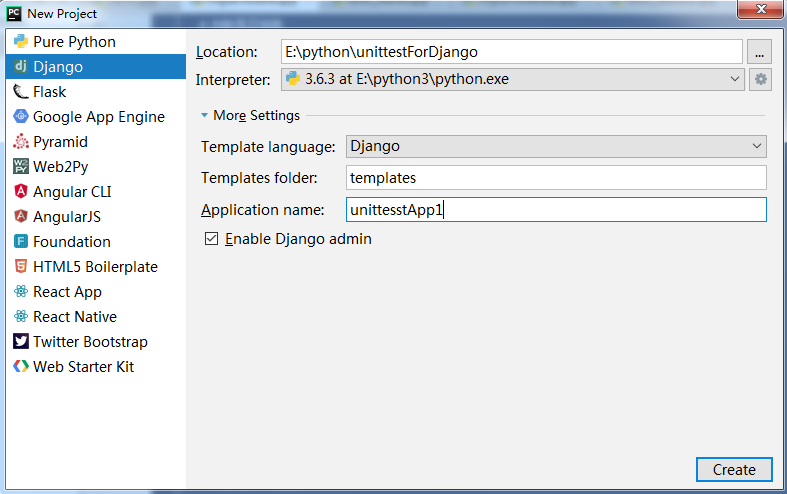
2、創建路由,這里我們使用二級路由
a、先復制工程目錄下的urls.py文件到app目錄下
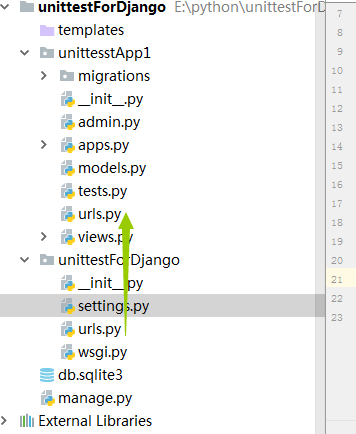
b、修改工程目錄下的urls.py文件,定義一級路由
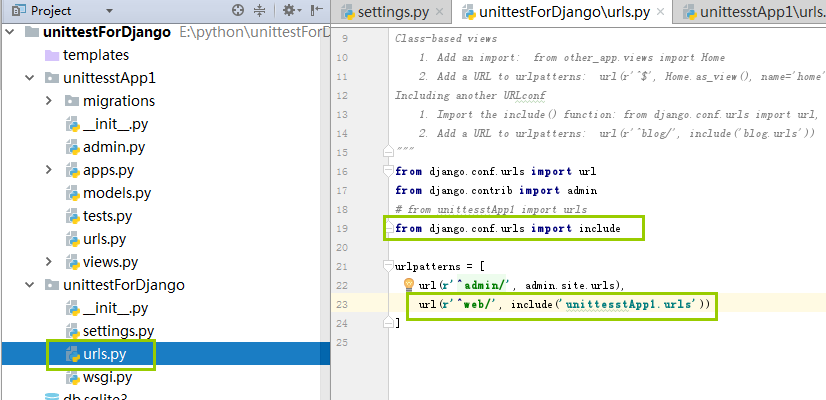
c、修改app目錄下的urls.py文件,設置二級路由,這里切記務必要刪除默認的admin這條路由
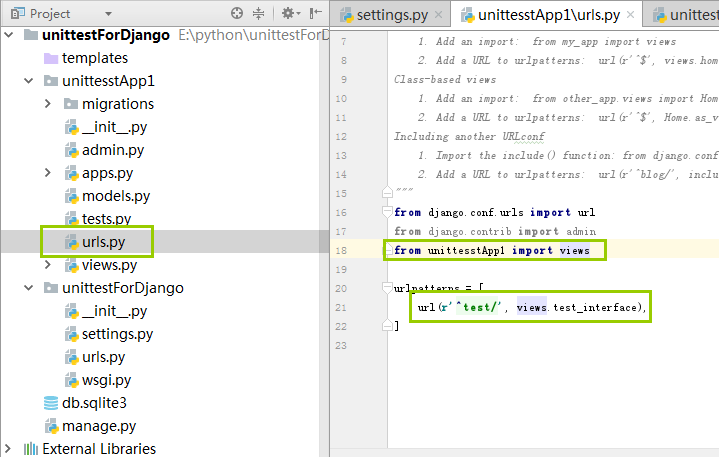
d、定義這條路由指向的視圖的函數
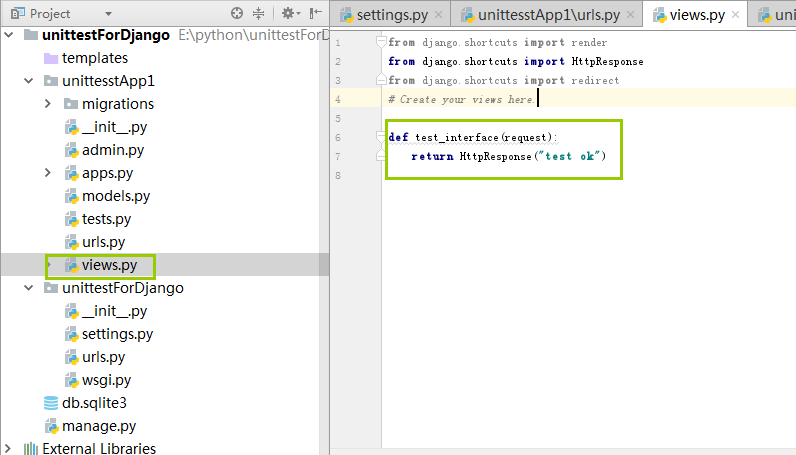
e、啟動django,這里我們使用9090端口啟動,因為我們的Jenkins端口用的是8080
E:\python\unittestForDjango>python manage.py runserver 9090
f、這里的是啟動成功的樣式,我圈住的告警可以忽略,因為這里Django的admin需要的,我們這里不會用到django的admin

g、打開瀏覽器訪問django,我們的一個簡單的Django項目已經跑通

3、在視圖函數中定義一個方法,這個方法分別處理GET請求和POST請求
a、定義視圖函數
這里通過這個參數告訴瀏覽器,我們返回的是JSON數據
return HttpResponse(result, content_type="application/json;charset=utf-8")
def test_login(request):
method = request.method.upper()
if method == "GET":
result = {}
name = request.GET.get("username",None)
pwd = request.GET.get("pwd",None)
result["name"] = name
result["pwd"] = pwd
result = json.dumps(result)
# return HttpResponse(result)
return HttpResponse(result, content_type="application/json;charset=utf-8")
else:
result = {}
name = request.POST.get("username",None)
pwd = request.POST.get("pwd",None)
result["name"] = name
result["pwd"] = pwd
result = json.dumps(result)
return HttpResponse(result,content_type="application/json;charset=utf-8")
b、使用request模塊發起POST和GET請求
#Auther Bob
#--*--conding:utf-8 --*--
import requests
import json
class TestCase(object):
def __init__(self,username,pwd,url):
self.username = username
self.pwd = pwd
self.url = url
def get(self):
# 發送get請求
url = self.url + "?username=" + str(self.username) + "&" + "pwd=" + str(self.pwd)
res = requests.get(url=url)
print(res.text,type(res.text))
def post(self):
# 發送post請求
data = {
"username" : self.username,
"pwd" : self.pwd
}
res = requests.post(url=self.url,data=data)
print(res.text)
if __name__ == '__main__':
url = "http://127.0.0.1:9090/web/login/"
username = "zhangsan"
pwd = "123"
t = TestCase(username,pwd,url)
t.get()
t.post()
c、這里我們引入unittest框架,測試案例可以這么寫
import unittest
from test3 import test_request
class TestDjango(unittest.TestCase):
def setUp(self):
print("unittest框架的前置條件")
def tearDown(self):
print("unittest框架的后置條件")
def test_01(self):
url = "http://127.0.0.1:9090/web/login/"
username = "zhangsan"
pwd = "123"
t = test_request.TestCase(url=url,username=username,pwd=pwd)
def test_02(self):
url = "http://127.0.0.1:9090/web/login/"
username = "zhangsan"
pwd = "123"
t = test_request.TestCase(url=url,username=username,pwd=pwd)
t.post()
if __name__ == '__main__':
unittest.main(verbosity=2)
d、這里有重復代碼,我們可以利用unittest框架中的classmethod來解決,因為實例化一個測試類可以放在前置條件中
import unittest
from test3 import test_request
class TestDjango(unittest.TestCase):
@classmethod
def setUpClass(cls):
url = "http://127.0.0.1:9090/web/login/"
username = "zhangsan"
pwd = "123"
# 這里的t雖然是類變量,但是python的中的實例是可以用引用類變量的
cls.t = test_request.TestCase(url=url,username=username,pwd=pwd)
def setUp(self):
print("unittest框架的前置條件")
def tearDown(self):
print("unittest框架的后置條件")
def test_01(self):
self.t.get()
def test_02(self):
self.t.post()
if __name__ == '__main__':
unittest.main(verbosity=2)
e、在testcase中加入斷言
import unittest
from test3 import test_request
class TestDjango(unittest.TestCase):
@classmethod
def setUpClass(cls):
url = "http://127.0.0.1:9090/web/login/"
username = "zhangsan"
pwd = "123"
# 這里的t雖然是類變量,但是python的中的實例是可以用引用類變量的
cls.t = test_request.TestCase(url=url,username=username,pwd=pwd)
def setUp(self):
print("unittest框架的前置條件")
def tearDown(self):
print("unittest框架的后置條件")
def test_01(self):
res = self.t.get()
self.assertEqual(200,res.status_code)
def test_02(self):
res = self.t.post()
self.assertEqual(200, res.status_code)
if __name__ == '__main__':
unittest.main(verbosity=2)
f、引入testsuite
import unittest from unittest import TestLoader from test3 import test_unittest if __name__ == '__main__': suite = unittest.TestSuite() loader = TestLoader() test_cases1 = unittest.TestLoader().loadTestsFromModule(test_unittest) # 參數是一個模塊,會把這個模塊里的所有case加載進來 suite.addTests(test_cases1) runner = unittest.TextTestRunner(verbosity=2) runner.run(suite)
二、在django中設計接口
這里我們寫一個簡單的例子,設計一個用戶表,設計4個接口
接口1:登陸
接口2:增加用戶,需要用戶登陸
接口3:刪除用戶,需要用戶登陸
接口4:查詢用戶,不需要用戶登陸
1、先看登陸接口
a、登錄接口對應的url
下面是一級路由
url(r'^web/', include('unittesstApp1.urls'))
下面是二級路由
url(r'^login/', views.test_login),
b、登錄接口的視圖函數
def test_login(request):
method = request.method.upper()
if method == "GET":
returndict = {"code": 200, "error": None}
username = request.GET.get("username",None)
password = request.GET.get("password",None)
if username == "admin" and password == "admin123.":
request.session["username"] = username
request.session["password"] = password
result = json.dumps(returndict)
else:
returndict["code"] = 201
returndict["error"] = "用戶名或者密碼錯誤"
result = json.dumps(returndict)
return HttpResponse(result,content_type="application/json;charset=utf-8")
這里我們用到了session來代替cookies
2、增加用戶接口
a、增加用戶對應的url
一級路由同登陸接口,下面是二級路由
url(r'^add/', views.test_add),
b、增加用戶接口對應的視圖函數,這里我們做了各種異常處理,且判斷了用戶是否登陸,也就是通過是否攜帶cookies來判斷
def test_add(request):
method = request.method.upper()
if method == "POST":
returndict = {"code": 200, "error": None}
username = request.session.get("username",None)
password = request.session.get("password",None)
if username == "admin" and password == "admin123.":
newusername = request.POST.get("username",None)
age = request.POST.get("age",None)
sex = request.POST.get("sex",None)
pwd = request.POST.get("pwd",None)
userinfo = [newusername,age,sex,pwd]
print(userinfo)
if not "None" in userinfo and all(userinfo):
if models.userInfo.objects.filter(username = userinfo[0]).exists():
returndict["error"] = "{username} is exists,please add a new username".format(username = username)
returndict["code"] = 201
result = json.dumps(returndict)
return HttpResponse(result, content_type="application/json;charset=utf-8")
else:
models.userInfo.objects.create(
username = newusername,
age = age,
sex = sex,
pwd = pwd
)
if models.userInfo.objects.filter(username=userinfo[0]).exists():
result = json.dumps(returndict)
return HttpResponse(result, content_type="application/json;charset=utf-8")
else:
returndict["error"] = "{username} is error,please retry add".format(username=username)
returndict["code"] = 201
result = json.dumps(returndict)
return HttpResponse(result, content_type="application/json;charset=utf-8")
else:
returndict["error"] = "must input username,age,sex,pwd"
returndict["code"] = 201
result = json.dumps(returndict)
return HttpResponse(result, content_type="application/json;charset=utf-8")
else:
returndict = {"code": 201, "error": "用戶名或者密碼錯誤"}
result = json.dumps(returndict)
return HttpResponse(result, content_type="application/json;charset=utf-8")
3、刪除接口
a、刪除用戶對應的url
一級路由同登陸接口,這里只看二級路由
url(r'^del/', views.del_user),
b、刪除接口對應的視圖函數,這里我做了各種異常處理,也做了用戶是否登陸的檢測,也是通過檢測cookies來實現
def del_user(request):
method = request.method.upper()
if method == "POST":
returndict = {"code": 200, "error": None}
username = request.session.get("username",None)
password = request.session.get("password",None)
if username == "admin" and password == "admin123.":
delusername = request.POST.get("username",None)
print(delusername)
if delusername != None:
if models.userInfo.objects.filter(username=delusername).exists():
delid = models.userInfo.objects.get(username=delusername).id
print(delid)
try:
models.userInfo.objects.get(id=delid).delete()
except Exception as e:
returndict = {"code": 201, "error": e}
result = json.dumps(returndict)
return HttpResponse(result, content_type="application/json;charset=utf-8")
else:
result = json.dumps(returndict)
return HttpResponse(result, content_type="application/json;charset=utf-8")
else:
returndict = {"code": 201, "error": "{username} is not exists".format(username = delusername)}
result = json.dumps(returndict)
return HttpResponse(result, content_type="application/json;charset=utf-8")
else:
returndict = {"code": 201, "error": "you must input a username"}
result = json.dumps(returndict)
return HttpResponse(result, content_type="application/json;charset=utf-8")
else:
returndict = {"code": 201, "error": "username or password is error"}
result = json.dumps(returndict)
return HttpResponse(result, content_type="application/json;charset=utf-8")
4、查看接口
a、查看接口對應的url
一級路由同登陸接口url,下面是二級路由
url(r'^scan/', views.get_user),
b、查看接口對應的url,這里我們不檢測用戶是否登陸,直接把查到的數據返回給客戶,如果查詢報錯,才返回錯誤的信息
def get_user(request):
method = request.method.upper()
returndict = {"code": 200, "userinfo": None}
if method == "GET":
try:
alluser = models.userInfo.objects.all().values_list("username")
alluserlist = []
for i in alluser:
alluserlist.append(i)
returndict["userinfo"] = alluserlist
except Exception as e:
returndict["code"] = "201"
returndict["error"] = e
finally:
result = json.dumps(returndict)
return HttpResponse(result, content_type="application/json;charset=utf-8")
5、設計刪除數據庫中所有的接口,用來做后置條件
def del_alluser(request):
method = request.method.upper()
if method == "POST":
returndict = {"code": 200, "error": None}
username = request.session.get("username", None)
password = request.session.get("password", None)
if username == "admin" and password == "admin123.":
if models.userInfo.objects.all().count() > 0:
models.userInfo.objects.all().delete()
result = json.dumps(returndict)
return HttpResponse(result, content_type="application/json;charset=utf-8")
三、案例準備
1、在excel中寫好接口測試案例

2、定義常量,也就是每列對應的值
class TestConfig(object):
def __init__(self):
self.name = 0
self.url = 1
self.method = 2
self.cookies = 3
self.data = 4
self.res = 5
self.exec = 6
def getname(self):
return self.name
def geturl(self):
return self.url
def getmethod(self):
return self.method
def getcookies(self):
return self.cookies
def getdata(self):
return self.data
def getres(self):
return self.res
def getexec(self):
return self.exec
3、定義讀取excel的類,因為我要從excel中讀取案例
import xlrd
import os
class testexcel(object):
casepath = os.path.join(os.path.dirname(os.path.dirname(os.path.abspath(__file__))), "case", "testcase.xlsx")
def __init__(self):
self.casepath = testexcel.casepath
self.execlobj = xlrd.open_workbook(self.casepath)
self.sheetobj = self.execlobj.sheet_by_index(0)
def get_excel_data(self,row,col):
max_row = self.get_excel_max_row()
max_col = self.get_excel_max_col()
if row > max_row -1 or col > max_col - 1:
return False
else:
data = self.sheetobj.cell_value(row,col)
return data
def get_excel_max_row(self):
r_num = self.sheetobj.nrows
return r_num
def get_excel_max_col(self):
c_num = self.sheetobj.ncols
return c_num
4、定義我們的接口函數
import requests
import json
class TestLogin(object):
def __init__(self,username,pwd,url):
self.username = username
self.pwd = pwd
self.url = url
def get(self):
# 發送get請求
url = self.url + "?username=" + str(self.username) + "&" + "password=" + str(self.pwd)
res = requests.get(url=url,
headers={
"user-agent": "Mozilla/5.0 (Windows NT 6.1) AppleWebKit/537.36 (KHTML, like Gecko) Chrome/57.0.2987.133 Safari/537.36"
})
# print(json.loads(res.text))
return res
def post(self):
# 發送post請求
data = {
"username" : self.username,
"pwd" : self.pwd
}
res = requests.post(url=self.url,
data=data,
headers={
"user-agent": "Mozilla/5.0 (Windows NT 6.1) AppleWebKit/537.36 (KHTML, like Gecko) Chrome/57.0.2987.133 Safari/537.36"
},
)
# print(res.text)
return res
class TestAdd(object):
def __init__(self,username,age,sex,pwd,cookies,url):
self.username = username
self.age = age
self.sex = sex
self.pwd = pwd
self.url = url
self.cookies = cookies
def post(self):
# 發送post請求
data = {
"username" : self.username,
"pwd" : self.pwd,
"age" : self.age,
"sex" : self.sex
}
res = requests.post(url=self.url,
data=data,
headers={
"user-agent": "Mozilla/5.0 (Windows NT 6.1) AppleWebKit/537.36 (KHTML, like Gecko) Chrome/57.0.2987.133 Safari/537.36"
},
cookies=self.cookies,
)
# print(res.text)
return res
class Testdel(object):
def __init__(self, username,cookies,url):
self.username = username
self.cookies = cookies
self.url = url
def post(self):
# 發送post請求
data = {
"username": self.username,
}
res = requests.post(url=self.url,
data=data,
headers={
"user-agent": "Mozilla/5.0 (Windows NT 6.1) AppleWebKit/537.36 (KHTML, like Gecko) Chrome/57.0.2987.133 Safari/537.36"
},
cookies=self.cookies,
)
# print(res.text)
return res
class Testscan(object):
def __init__(self,url):
self.url = url
def get(self):
res = requests.get(url=self.url,
headers={
"user-agent": "Mozilla/5.0 (Windows NT 6.1) AppleWebKit/537.36 (KHTML, like Gecko) Chrome/57.0.2987.133 Safari/537.36"
},
cookies=None,
)
return res
5、定義測試案例
import unittest
from test3 import test_request
import json
from util import test_json
from util import test_excel
from case import testconfig
import requests
class TestDjango(unittest.TestCase):
@classmethod
def setUpClass(cls):
cls.alldata = test_json.testjson()
@classmethod
def tearDownClass(cls):
url = "http://127.0.0.1:9090/web/login/" + "?username=" + "admin" + "&" + "password=" + "admin123."
res = requests.get(url=url,
headers={
"user-agent": "Mozilla/5.0 (Windows NT 6.1) AppleWebKit/537.36 (KHTML, like Gecko) Chrome/57.0.2987.133 Safari/537.36"
})
url = "http://127.0.0.1:9090/web/delall/"
requests.post(url=url,
headers={
"user-agent": "Mozilla/5.0 (Windows NT 6.1) AppleWebKit/537.36 (KHTML, like Gecko) Chrome/57.0.2987.133 Safari/537.36"
},
cookies = res.cookies
)
def get_cookies(self):
url = "http://127.0.0.1:9090/web/login/" + "?username=" + "admin" + "&" + "password=" + "admin123."
res = requests.get(url=url,
headers={
"user-agent": "Mozilla/5.0 (Windows NT 6.1) AppleWebKit/537.36 (KHTML, like Gecko) Chrome/57.0.2987.133 Safari/537.36"
})
# print(json.loads(res.text))
return res.cookies
@unittest.skip('noexec')
def test_login_ok(self):
row = 1
configobj = testconfig.TestConfig()
excelobj = test_excel.testexcel()
execstatus = excelobj.get_excel_data(row,configobj.getexec())
if execstatus == "YES":
cookiesstatus = excelobj.get_excel_data(row, configobj.getcookies())
if cookiesstatus == "YES":
cookies = self.get_cookies()
else:
cookies = None
data = excelobj.get_excel_data(row, configobj.getdata())
data = json.loads(data)
url = excelobj.get_excel_data(row, configobj.geturl())
res = excelobj.get_excel_data(row, configobj.getres())
method = excelobj.get_excel_data(row, configobj.getmethod())
if method == "GET":
testobj = test_request.TestLogin(data["username"],data["pwd"],url)
resobj = testobj.get()
self.assertEqual(int(res),json.loads(resobj.text)["code"])
@unittest.skip('noexec')
def test_login_pwd_error(self):
row = 2
configobj = testconfig.TestConfig()
excelobj = test_excel.testexcel()
execstatus = excelobj.get_excel_data(row,configobj.getexec())
if execstatus == "YES":
cookiesstatus = excelobj.get_excel_data(row, configobj.getcookies())
if cookiesstatus == "YES":
cookies = self.get_cookies()
else:
cookies = None
data = excelobj.get_excel_data(row, configobj.getdata())
data = json.loads(data)
url = excelobj.get_excel_data(row, configobj.geturl())
res = excelobj.get_excel_data(row, configobj.getres())
method = excelobj.get_excel_data(row, configobj.getmethod())
if method == "GET":
testobj = test_request.TestLogin(data["username"],data["pwd"],url)
resobj = testobj.get()
self.assertEqual(int(res),json.loads(resobj.text)["code"])
@unittest.skip('noexec')
def test_login_user_error(self):
row = 3
configobj = testconfig.TestConfig()
excelobj = test_excel.testexcel()
execstatus = excelobj.get_excel_data(row,configobj.getexec())
if execstatus == "YES":
cookiesstatus = excelobj.get_excel_data(row, configobj.getcookies())
if cookiesstatus == "YES":
cookies = self.get_cookies()
else:
cookies = None
data = excelobj.get_excel_data(row, configobj.getdata())
data = json.loads(data)
url = excelobj.get_excel_data(row, configobj.geturl())
res = excelobj.get_excel_data(row, configobj.getres())
method = excelobj.get_excel_data(row, configobj.getmethod())
if method == "GET":
testobj = test_request.TestLogin(data["username"],data["pwd"],url)
resobj = testobj.get()
self.assertEqual(int(res),json.loads(resobj.text)["code"])
@unittest.skip('noexec')
def test_user_pwd_error(self):
row = 4
configobj = testconfig.TestConfig()
excelobj = test_excel.testexcel()
execstatus = excelobj.get_excel_data(row,configobj.getexec())
if execstatus == "YES":
cookiesstatus = excelobj.get_excel_data(row, configobj.getcookies())
if cookiesstatus == "YES":
cookies = self.get_cookies()
else:
cookies = None
data = excelobj.get_excel_data(row, configobj.getdata())
data = json.loads(data)
url = excelobj.get_excel_data(row, configobj.geturl())
res = excelobj.get_excel_data(row, configobj.getres())
method = excelobj.get_excel_data(row, configobj.getmethod())
if method == "GET":
testobj = test_request.TestLogin(data["username"],data["pwd"],url)
resobj = testobj.get()
self.assertEqual(int(res),json.loads(resobj.text)["code"])
@unittest.skip('noexec')
def test_insert_ok(self):
row = 5
configobj = testconfig.TestConfig()
excelobj = test_excel.testexcel()
execstatus = excelobj.get_excel_data(row, configobj.getexec())
if execstatus == "YES":
cookiesstatus = excelobj.get_excel_data(row, configobj.getcookies())
if cookiesstatus == "YES":
cookies = self.get_cookies()
else:
cookies = None
data = excelobj.get_excel_data(row, configobj.getdata())
data = json.loads(data)
url = excelobj.get_excel_data(row, configobj.geturl())
res = excelobj.get_excel_data(row, configobj.getres())
method = excelobj.get_excel_data(row, configobj.getmethod())
if method == "POST":
testobj = test_request.TestAdd(data["username"], data["age"],data["sex"], data["pwd"],cookies,url)
resobj = testobj.post()
print(json.loads(resobj.text))
self.assertEqual(int(res), json.loads(resobj.text)["code"])
@unittest.skip('noexec')
def test_insert_nologin(self):
row = 6
configobj = testconfig.TestConfig()
excelobj = test_excel.testexcel()
execstatus = excelobj.get_excel_data(row, configobj.getexec())
if execstatus == "YES":
cookiesstatus = excelobj.get_excel_data(row, configobj.getcookies())
if cookiesstatus == "YES":
cookies = self.get_cookies()
else:
cookies = None
data = excelobj.get_excel_data(row, configobj.getdata())
data = json.loads(data)
url = excelobj.get_excel_data(row, configobj.geturl())
res = excelobj.get_excel_data(row, configobj.getres())
method = excelobj.get_excel_data(row, configobj.getmethod())
if method == "POST":
testobj = test_request.TestAdd(data["username"], data["age"],data["sex"], data["pwd"],cookies,url)
resobj = testobj.post()
print(json.loads(resobj.text))
self.assertEqual(int(res), json.loads(resobj.text)["code"])
@unittest.skip("noexec")
def test_insert_user_error(self):
row = 7
configobj = testconfig.TestConfig()
excelobj = test_excel.testexcel()
execstatus = excelobj.get_excel_data(row, configobj.getexec())
if execstatus == "YES":
cookiesstatus = excelobj.get_excel_data(row, configobj.getcookies())
if cookiesstatus == "YES":
cookies = self.get_cookies()
else:
cookies = None
data = excelobj.get_excel_data(row, configobj.getdata())
data = json.loads(data)
url = excelobj.get_excel_data(row, configobj.geturl())
res = excelobj.get_excel_data(row, configobj.getres())
method = excelobj.get_excel_data(row, configobj.getmethod())
if method == "POST":
testobj = test_request.TestAdd(data.get("username",None), data.get("age",None), data.get("sex",None), data.get("pwd",None), cookies, url)
resobj = testobj.post()
print(json.loads(resobj.text))
self.assertEqual(int(res), json.loads(resobj.text)["code"])
@unittest.skip('no exec')
def test_insert_pwd_error(self):
row = 8
configobj = testconfig.TestConfig()
excelobj = test_excel.testexcel()
execstatus = excelobj.get_excel_data(row, configobj.getexec())
if execstatus == "YES":
cookiesstatus = excelobj.get_excel_data(row, configobj.getcookies())
if cookiesstatus == "YES":
cookies = self.get_cookies()
else:
cookies = None
data = excelobj.get_excel_data(row, configobj.getdata())
data = json.loads(data)
url = excelobj.get_excel_data(row, configobj.geturl())
res = excelobj.get_excel_data(row, configobj.getres())
method = excelobj.get_excel_data(row, configobj.getmethod())
if method == "POST":
testobj = test_request.TestAdd(data.get("username",None), data.get("age",None), data.get("sex",None), data.get("pwd",None), cookies, url)
resobj = testobj.post()
print(json.loads(resobj.text))
self.assertEqual(int(res), json.loads(resobj.text)["code"])
@unittest.skip("no exec")
def test_insert_sex_error(self):
row = 9
configobj = testconfig.TestConfig()
excelobj = test_excel.testexcel()
execstatus = excelobj.get_excel_data(row, configobj.getexec())
if execstatus == "YES":
cookiesstatus = excelobj.get_excel_data(row, configobj.getcookies())
if cookiesstatus == "YES":
cookies = self.get_cookies()
else:
cookies = None
data = excelobj.get_excel_data(row, configobj.getdata())
print(data)
data = json.loads(data)
print(data)
url = excelobj.get_excel_data(row, configobj.geturl())
res = excelobj.get_excel_data(row, configobj.getres())
method = excelobj.get_excel_data(row, configobj.getmethod())
if method == "POST":
testobj = test_request.TestAdd(data.get("username",None), data.get("age",None), data.get("sex",None), data.get("pwd",None), cookies, url)
resobj = testobj.post()
print(json.loads(resobj.text))
self.assertEqual(int(res), json.loads(resobj.text)["code"])
@unittest.skip('no exec')
def test_insert_age_error(self):
row = 10
configobj = testconfig.TestConfig()
excelobj = test_excel.testexcel()
execstatus = excelobj.get_excel_data(row, configobj.getexec())
if execstatus == "YES":
cookiesstatus = excelobj.get_excel_data(row, configobj.getcookies())
if cookiesstatus == "YES":
cookies = self.get_cookies()
else:
cookies = None
data = excelobj.get_excel_data(row, configobj.getdata())
print(data)
data = json.loads(data)
print(data)
url = excelobj.get_excel_data(row, configobj.geturl())
res = excelobj.get_excel_data(row, configobj.getres())
method = excelobj.get_excel_data(row, configobj.getmethod())
if method == "POST":
testobj = test_request.TestAdd(data.get("username",None), data.get("age",None), data.get("sex",None), data.get("pwd",None), cookies, url)
resobj = testobj.post()
print(resobj.text)
print(json.loads(resobj.text))
self.assertEqual(int(res), json.loads(resobj.text)["code"])
@unittest.skip('no exec')
def test_insert_user_exist(self):
row = 11
configobj = testconfig.TestConfig()
excelobj = test_excel.testexcel()
execstatus = excelobj.get_excel_data(row, configobj.getexec())
if execstatus == "YES":
cookiesstatus = excelobj.get_excel_data(row, configobj.getcookies())
if cookiesstatus == "YES":
cookies = self.get_cookies()
else:
cookies = None
data = excelobj.get_excel_data(row, configobj.getdata())
print(data)
data = json.loads(data)
print(data)
url = excelobj.get_excel_data(row, configobj.geturl())
res = excelobj.get_excel_data(row, configobj.getres())
method = excelobj.get_excel_data(row, configobj.getmethod())
if method == "POST":
testobj = test_request.TestAdd(data.get("username", None), data.get("age", None), data.get("sex", None),
data.get("pwd", None), cookies, url)
resobj = testobj.post()
print(resobj.text)
print(json.loads(resobj.text))
self.assertEqual(int(res), json.loads(resobj.text)["code"])
def test_get_user(self):
row = 12
configobj = testconfig.TestConfig()
excelobj = test_excel.testexcel()
execstatus = excelobj.get_excel_data(row, configobj.getexec())
if execstatus == "YES":
cookiesstatus = excelobj.get_excel_data(row, configobj.getcookies())
if cookiesstatus == "YES":
cookies = self.get_cookies()
else:
cookies = None
url = excelobj.get_excel_data(row, configobj.geturl())
res = excelobj.get_excel_data(row, configobj.getres())
method = excelobj.get_excel_data(row, configobj.getmethod())
if method == "POST":
testobj = test_request.Testscan(url)
resobj = testobj.get()
# print(resobj.text
print(json.loads(resobj.text))
self.assertEqual(int(res), json.loads(resobj.text)["code"])
@unittest.skip('no exec')
def test_del_user(self):
row = 13
configobj = testconfig.TestConfig()
excelobj = test_excel.testexcel()
execstatus = excelobj.get_excel_data(row, configobj.getexec())
if execstatus == "YES":
cookiesstatus = excelobj.get_excel_data(row, configobj.getcookies())
if cookiesstatus == "YES":
cookies = self.get_cookies()
else:
cookies = None
data = excelobj.get_excel_data(row, configobj.getdata())
print(data)
data = json.loads(data)
print(data)
url = excelobj.get_excel_data(row, configobj.geturl())
res = excelobj.get_excel_data(row, configobj.getres())
method = excelobj.get_excel_data(row, configobj.getmethod())
if method == "POST":
testobj = test_request.Testdel(data.get("username", None),cookies, url)
resobj = testobj.post()
print(resobj.text)
print(json.loads(resobj.text))
self.assertEqual(int(res), json.loads(resobj.text)["code"])
def test_del_noexistuser(self):
row = 14
configobj = testconfig.TestConfig()
excelobj = test_excel.testexcel()
execstatus = excelobj.get_excel_data(row, configobj.getexec())
if execstatus == "YES":
cookiesstatus = excelobj.get_excel_data(row, configobj.getcookies())
if cookiesstatus == "YES":
cookies = self.get_cookies()
else:
cookies = None
data = excelobj.get_excel_data(row, configobj.getdata())
print(data)
data = json.loads(data)
print(data)
url = excelobj.get_excel_data(row, configobj.geturl())
res = excelobj.get_excel_data(row, configobj.getres())
method = excelobj.get_excel_data(row, configobj.getmethod())
if method == "POST":
testobj = test_request.Testdel(data.get("username", None),cookies, url)
resobj = testobj.post()
print(resobj.text)
print(json.loads(resobj.text))
self.assertEqual(int(res), json.loads(resobj.text)["code"])
6、引入unittest的suit,組織案例
import unittest from unittest import TestLoader from test3 import test_unittest if __name__ == '__main__': suite = unittest.TestSuite() loader = TestLoader() test_cases1 = unittest.TestLoader().loadTestsFromModule(test_unittest) # 參數是一個模塊,會把這個模塊里的所有case加載進來 suite.addTests(test_cases1) runner = unittest.TextTestRunner(verbosity=2) runner.run(suite)
四、執行案例
1、啟動django
E:\python\unittestForDjango>python manage.py runserver 9090
Performing system checks...System check identified no issues (0 silenced).
October 19, 2019 - 22:46:42
Django version 1.11.7, using settings 'unittestForDjango.settings'
Starting development server at http://127.0.0.1:9090/
Quit the server with CTRL-BREAK
2、執行測試套件
test_del_noexistuser (test3.test_unittest.TestDjango) ... {"username":"test1"}
{'username': 'test1'}
ok
test_del_user (test3.test_unittest.TestDjango) ... skipped 'no exec'
test_get_user (test3.test_unittest.TestDjango) ... {"code": 201, "error": "test1 is not exists"}
{'code': 201, 'error': 'test1 is not exists'}
{'code': 200, 'userinfo': []}
ok
test_insert_age_error (test3.test_unittest.TestDjango) ... skipped 'no exec'
test_insert_nologin (test3.test_unittest.TestDjango) ... skipped 'noexec'
test_insert_ok (test3.test_unittest.TestDjango) ... skipped 'noexec'
test_insert_pwd_error (test3.test_unittest.TestDjango) ... skipped 'no exec'
test_insert_sex_error (test3.test_unittest.TestDjango) ... skipped 'no exec'
test_insert_user_error (test3.test_unittest.TestDjango) ... skipped 'noexec'
test_insert_user_exist (test3.test_unittest.TestDjango) ... skipped 'no exec'
test_login_ok (test3.test_unittest.TestDjango) ... skipped 'noexec'
test_login_pwd_error (test3.test_unittest.TestDjango) ... skipped 'noexec'
test_login_user_error (test3.test_unittest.TestDjango) ... skipped 'noexec'
test_user_pwd_error (test3.test_unittest.TestDjango) ... skipped 'noexec'
----------------------------------------------------------------------
Ran 14 tests in 1.466s
OK (skipped=12)
到此這篇關于python自動化測試三部曲之request+django實現接口測試的文章就介紹到這了,更多相關request django 接口測試內容請搜索億速云以前的文章或繼續瀏覽下面的相關文章希望大家以后多多支持億速云!
免責聲明:本站發布的內容(圖片、視頻和文字)以原創、轉載和分享為主,文章觀點不代表本網站立場,如果涉及侵權請聯系站長郵箱:is@yisu.com進行舉報,并提供相關證據,一經查實,將立刻刪除涉嫌侵權內容。